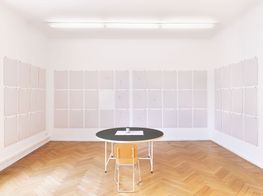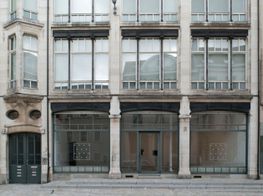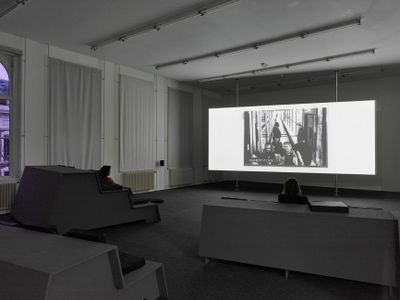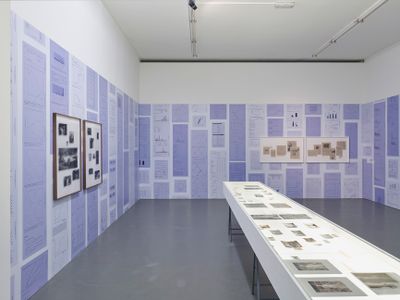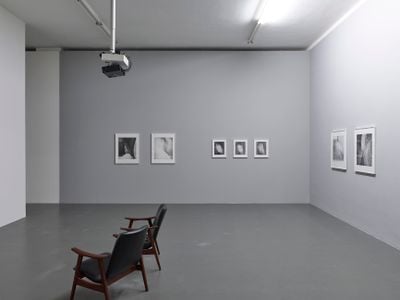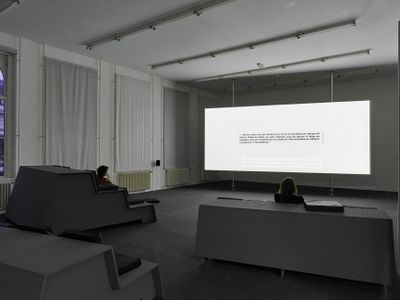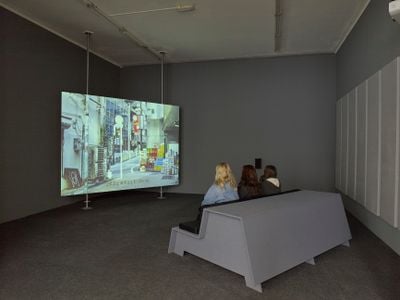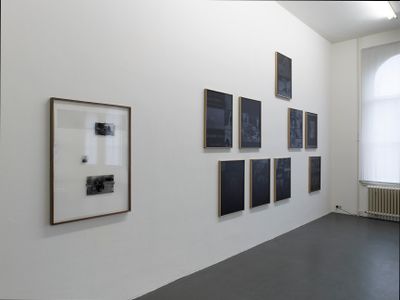Eric Baudelaire
Eric Baudelaire. Courtesy Witte de With Center for Contemporary Art, Rotterdam. Photo: Aad Hoogendoorn.
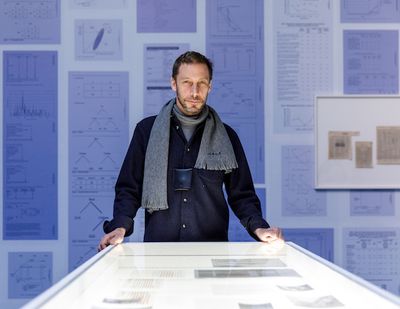
Eric Baudelaire. Courtesy Witte de With Center for Contemporary Art, Rotterdam. Photo: Aad Hoogendoorn.
About ten years ago, French visual artist Eric Baudelaire migrated from the social sciences to the field of art and filmmaking. To this day, his artistic practice is inspired by his former training and the research-driven approach that comes with it. Baudelaire mostly works in film and video installations, but he also uses photography, collage and printmaking techniques. His working process often takes inspiration from a dialogue or transaction between him and a collaborator, which usually takes place across distant geographic locations, activating a sense of displacement between two highly distinct social and political contexts. Such collaborators can be historical figures as much as contemporary colleagues or fictional characters. In essence, Baudelaire is a storyteller, a spinner of historical and biographical yarns with a keen eye for breaking down political narratives and using their visual modes of representation to piece the elements together into something of his own. For Baudelaire, the exchange between him and his collaborators is a conduit to reimagine possible narrative links between two contexts via oral histories, historical documents and fictional elements that surround the story he wants to tell. In weaving them together, he never dissolves the distinct qualities of his source material, but charges them up against each other by 'juxtaposing fictions that have documentary tendencies with documents that open fictional spaces'. This sort of magnetism between narrative poles and antipodes induces a shared space or condition—between the subjects of his films, the viewer, and himself—vis-á-vis certain social contexts and political affairs.
The Music of Ramón Raquello and his Orchestra is Baudelaire's largest monographic exhibition to date and currently on view at Witte de With Center for Contemporary Art in Rotterdam (27 January–7 May 2017). It spans ten years of artistic production since 2007, including collages, photographs, videos, films, and installation works, and spreads across the institution's entire second floor in an open fashion without curtains or enclosing walls. The exhibition space is roughly divided into four main sections, anchored by two large film installations and a number of smaller moving image and paper-based works.
One of the two film installations features The Anabasis of May and Fusako Shigenobu, Masao Adachi and 27 Years without Images (2011), Baudelaire's first full-length film and perhaps his most popular work. It tells the story of Masao Adachi, avant-garde filmmaker and former member of the Japanese Red Army, tracing how his entanglement in militant aesthetics and radical left politics has affected the personal lives and political views of him and his family. The film blends personal accounts with propaganda material and other archival footage into a collective memory of that shared past, interspersed with present-day landscape images from Tokyo and Beirut. The latter alludes to the so-called 'landscape theory' and its first introduction in the 1969 film A.K.A. Serial Killer, which was codirected by Adachi and shows nothing but landscapes and places in Japan that a convicted serial killer supposedly traversed throughout his life. The filmmakers saw in it a way to reveal how power relations exert an alienating force by inscribing themselves into everyday environments.
For Baudelaire, both Adachi's and the serial killer's biographies are reminiscent of the 370 BC book Anabasis, in which Greek military commander and author Xenophon chronicles the journey of an army of mercenaries who, due to the death of their leader, unexpectedly lose their sense of orientation on unknown territory and subsequently try to return home. As literary motif, the idea of the anabasis has since been interpreted and re-appropriated in many ways. From ancient plot to its modern variations, it is symbolic for the sudden collapse of one's sense of order in a hostile land and the ensuing process of inner and outer reorientation.
It is also at the base of Baudelaire's latest film, Also known as Jihadi (2017), which premiered in the Witte de With exhibition and dominates the other of the two major installations with a large and open screening area. Over 99 minutes, the film tracks the itinerary of a young Frenchman, Abdel Aziz Mekki, on his way from Paris via Egypt to Syria, where he plans to join the terrorist Al-Nusra front. Like A.K.A. Serial Killer, the film portrays its subject by showing landscapes and stations along his journey, from his home in a Parisian suburb to Syria and back. We never see Aziz himself appear throughout the duration of the film; all we know about him is revealed exclusively through court files collected by the French authorities to build a criminal case on him. Baudelaire inserts these clues about Aziz into his film like puzzle pieces that eventually come together to form a greater picture about him and his motivations to seek answers in radicalised violence.
Jens Maier-Rothe spoke with Baudelaire in Rotterdam on the occasion of The Music of Ramón Raquello and his Orchestra at Witte de With.
JMYour works often tell the story of a journey and its changing effect on your protagonist. How would you describe your own journey as an artist? What was your point of departure and where are you now? You often mention your background in social and political sciences, which also has a strong presence in the exhibition.
EBI never used to talk about this. For ten years I didn't bother mentioning where I came from. It became important only about a year ago when I did a kind of artistic self-psychoanalysis and began to think about the relationship between different aspects of the practice. I never had this moment of reflection until then. In art schools, you may study the lives of artists and see how the progression of their careers made them arrive at certain bodies of works. Or perhaps that's what art history is concerned with. Having not gone through that route, neither studying art nor art history, my understanding of things is perhaps more itinerant.
My process has been somewhat bizarre and organic. I worked for ten years in various fields and then decided to become a documentary photographer. But my very first project made me aware of many problematic issues in the documentary field. I started bumping up against so many obstacles that I had to do something differently. Since then I've never had a plan or a global picture, I just did one piece after another and now it has been 10 or 12 years. When I look back at all these years, I see the path of a social scientist who dropped out of his discipline, wandered around for a while and then returned to the same essential questions, but with a shift in the methodology. Switching from social scientist to photographer brought radical changes with it. One is that I gave up on words. I started hoping an image could do what words used to do for me. Abandoning the structures and theories of so-called 'social science' inevitably caused a crisis and a lot of doubts. But after a while it became amusing to me to say that I still work on the same problems but with different tools.
Today, I don't say that I come from the social sciences as a way of legitimising my art practice. I say that one could look at what I do as an alternative form of social science, a form I've been wrestling with for the past 20 years. The exhibition at the Witte de With is the first time I've been able to see so many of my works together in one space. When you begin to mull over ideas for a show of this scale, you start seeing connections. I wanted to make the link to the social sciences explicit with the 420 diagrams in the wallpaper piece, [FRAEMWROK FRMAWREOK FAMREWROK... (2016)], that is central to the show's layout.
JMThe exhibition draws its title from a fictional orchestra in Orson Welles' radio play The War of the Worlds from 1938. How did the spatial layout take shape, and what brought the fictional character of Ramón Raquello to your mind when developing the show?
EBMy plans for the show started out with the selection of works. I decided that the earliest work in the show would be the video Sugar Water from 2007. It is presented on a monitor at the entrance and sort of introduces a variety of works I have produced since then. The exhibition is bookended by two feature length films: one is The Anabasis... (2011) and the other is the recently finished Also known as Jihadi (2017). When one of the curators of the show, Natasha Hoare, Skyped with me for the first time, I showed her my first floorplan sketch and she laughed because she had made an almost identical one. Given the scale and geography of the space, certain things immediately made sense, as if the spatial layout itself requested a certain kind of association between the works.
It felt important to give a name to the show. I like the idea that a title provides its own narrative. I chose mine because it felt timely. It seemed like an allegorically accurate way of placing all the different stories contained in my works under one simple but evocative story of a hypothetical man who is supposed to play music for an hour on the radio, and is continuously interrupted by news flashes that announce the end of civilisation. Unpacking the story is wonderful: Bernard Hermann encounters Orson Welles, takes on the name Ramón Raquello for a radio play interpretation of H. G. Wells' The War of the Worlds (1898), and then Hermann goes on to have a brilliant career in Hollywood. Parallel to that narrative we have the fascinating history of radio, how its emergence destabilised the way politics and news coexisted at the time. Goebbels understood the power of radio as a mass medium, Roosevelt used it as a way to sell his New Deal. Radio became a powerful mass medium that threatened the reign of newspapers. I can't help thinking how similar it is to the internet and Twitter disrupting the course of political and news cycles today.
At some point, the idea came up to open the show with the music of Ramón Raquello spliced back together and played on an old radio that we found at the Witte de With. We cut out all of Orson Welles' interruptions and gave back to Ramón what belonged to Ramón: just music, no more fake news.
JMThe gesture of faking or transforming original stories and documents is a recurrent technique in your practice. A lot of your paper-based works depart from the idea of censorship and ways to deal with it; your video Sugar Water entails a huge trompe-l'œil in the size of an advertisement billboard in a fake Paris metro station. At the same time, building trust in the veracity of the original stories you adopt is important as well. How do you navigate between the two?
EBYou could boil down my practice to a simple question and a bunch of stories: what can an image do? And perhaps a corollary question: what is the relationship between words and images? The first question is as old as art history and inevitably brings us to the relationship between images and events. Here, I mean dramatic events, catastrophes and political turmoil. I've always gravitated towards art in its relationship to reality, seeing it as a way of thinking about the world and translating a thought, or usually a question, into a form. Samuel Beckett said the task of the artist is to find 'a form that accommodates the mess'. That's what draws me to art. You can look at every work in the show through one of these two questions, from the collected research materials in the vitrine, to the gravures made from scratched magazine pages in Of Signs & Senses (2009). It's all about the image's relationship to desire and obscenity: whether an image can capture desire, whether an image is obscene or not, whether an image transcends simple descriptive representation into something else.
The history of self-censorship in Japan is a great allegory in this regard. The Japanese penal code from 1907 stipulates that you can't sell anything obscene, while the Japanese constitution from 1947, written under US occupation, has the notion of freedom of speech embedded into it, therefore stipulating that there can be no censorship. Both texts are in contradiction, so how does that work itself out? When the 1928 novel Lady Chatterley's Lover by D.H. Lawrence was censored in Japan, the Supreme Court struggled to define obscenity and eventually came up with a definition: 'that which unnecessarily excites human desire'. While nothing in Japan obliges people to scratch off genitals from magazine pages, distributors do it in a form of preventative self-censorship to comply with the penal code. When you buy a copy of Artforum in Japan and leaf through the pages, you may come across an advertising for a Robert Mapplethorpe show at Galerie Thaddaeus Ropac with a huge penis on it. Most likely someone at the distributor's warehouse has taken a blade and scratched it out. Back in the 70s, they used a black marker. If you find an old Playboy magazine at a flea market in Japan, you sometimes see an enormous black square running from thighs to belly button, it looks like a big square bathing suit over the nude models. Over the years, they began to scratch off the ink instead of masking it.
My gesture with the gravures is very simple: I bought the Artforum with the Mapplethorpe picture, I blew up the scratched area to a large size and turned it back into an artwork as a heliogravure. What was art became pornography when it was deemed by the 'scratcher' to be obscene. I pursued the journey of this form, which had become a scratched-out form, bringing it back to the status of 'artwork' in the very classical form of a heliogravure.
JMA substantial amount of your work builds on conversations with others. You often borrow parts of their biographies or stories and appropriate them into your work, sometimes contradicting them along the way. Your relationship with Masao Adachi has been quite intimate and lasted over a long time. Your new film, Also known as Jihadi, seems to break with that tradition; you keep a bureaucratic distance to your protagonist Abdel Aziz Mekki and his motivations. Is that because of the present and tangible urgency of the topic?
EBIt would have been possible to make a film based on a personal relationship with someone with a story similar to Aziz's. It's not the nature of the story itself that made it necessary for me to be distant from him. But I wanted to depart from the way in which I have worked so far. So I made a few changes. My past few films have been based on audio narratives and this time I wanted to work without voiceover. I also wanted to make a film in France, and I wanted to make a film about something that is happening now. Above all, I didn't want to problematise a story with someone I have a personal relationship with, as I did in films like The Ugly One (2013) or Letters to Max (2014).
In the social sciences, there is a recurrent, fundamental question about how you deal with your source: the human subject as source material, how to obtain 'objective' data from a human source. Volumes have been written about this, and in my previous films, the way I have dealt with the question has been to throw away the notion of objectivity and turn the situation upside down: how do I provoke, how do I put the speech of the subject in danger, especially if this speech represents something problematic. This time around, I wanted to change the methodology and actually work without a relationship to the character. That meant not being in direct contact, it also meant changing all the names, dates and locations. The story had to be real, it had to be accurate and deal with the present, but turned into a cinematic abstraction. I felt it would free me up to think differently and not fall back on certain patterns. I have a hard time with artists or filmmakers who follow the same path too often, for too long, and then ossify.
In Also known as Jihadi, the document tells the story and carries the narrative in a very factual way. This system can either feel cold and distanced, or it can become a skeleton on which people build their own narrative, and imagine various personalities. I've witnessed different reactions to the film. One was that it feels cerebral and emotionless, but I've also witnessed the complete opposite. I suspect that it will be digested as a film where the main character becomes incarnated in people's projections of him, in a way that will make him human and touching. Some friends have told me that it is my most cinematic film. What I think they mean is that there is a story with a character, there is dialogue, an intrigue, there is mystery, and so on. It can be experienced as a genre film, more so than a documentary.
JMWith The Anabasis... and Also known as Jihadi, both the landscape theory concept and the idea of the anabasis have become cyclically recurring leitmotifs in your practice. What brought you back to working with these two narrative devices?
EBWhy do I keep on coming back to these forms of anabasis? Honestly, I don't know. Perhaps it's a question I should investigate in psychoanalysis [laughs]. I'm certainly caught in cyclical patterns in my works. You can see them in the narrative of the films, you can even see them in a lot of individual shots that compose the films, tracking shots that begin and end in the same place. I have always been touched by this movement described as anabasis: you depart hoping to find something new, and you end up finding that you have come back to the place where you began, but you have changed.
I don't know why this figure is so important to me, but I remember already being touched by it when reading Charles Baudelaire's Flowers of Evil (1857) as a teenager. You can look at the entire cycle of what happens in that book as a form of anabasis: in the final poem 'Le Voyage', the poet explains that he has tried all kinds of means of escape: wine, hashish, travels ... but even the infinity of the sea was not sufficient to drown what he calls spleen. His form of existential anxiety never disappears regardless of which journey he undertakes. Death is the only journey he is hopeful to engage in, because its endpoint is the only one that remains unknown. The poem opens with this beautiful stanza: 'To a child fond of maps and engravings / The universe is the size of his immense hunger / How vast is the world in the brightness of lamps / How small it appears in the eyes of memory'.
JMThe two films have a lot in common, yet they are very different. While The Anabasis... operates closer to this idea of anabasis as an unguided wandering through unknown territory, Also known as Jihadi is quite determined in the way it traces Aziz's journey, following a precise script from beginning to end.
EBThere is an obvious similarity, which I wasn't really aware of until I had already decided who the character should be and advanced a lot on the planning of the film. You can certainly look at Also known as Jihadi as an anabasis. It is a return that didn't want to be a return but ended up being a return, despite the will of the main character. In a way, Aziz's journey is identical to Masao Adachi's journey: both planned to make a life for themselves in Lebanon/Syria, both got arrested and sent back home. Their anabases are not simply geographic journeys, they are ideological journeys, both characters wanted to invent a new life for themselves in their journeys, in the political and in the personal sense.
JMIn Xenophon's Anabasis, the mercenaries lost their orientation when the prince who hired them died. What happened to Adachi and Aziz that caused their sense of orientation to collapse?
EBIn the case of The Anabasis..., there are many losses: the Soviet Union collapses, Syria stops providing funding for the Popular Front for the Liberation of Palestine, the Berlin Wall comes crashing down and suddenly nobody is looking after the Japanese Red Army. It's not the death of a prince, it's the death of a bipolar world order that protected left-wing guerrilla movements, that funded and financed them. Suddenly this order disappeared and the Japanese Red Army went wandering. In the case of Aziz, there is a sense of disappointment in the transcripts of his conversations with the investigating judge. I guess Rakka wasn't what he hoped it would be. But there is something desperate about his search. Some of the young people who travel to Syria hope to find martyrdom, they hope to die because their reading of Islam gives them a sense that they might find something beautiful in death. But some of them end up not wanting to die, and they return without having found any form of exaltation or answer to their existential questions.
JMThis brings us back to what you said earlier about art and its relationship to reality, that art is a way of understanding the world and translating that into form. You mentioned that the Paris attacks of 13 November 2015, and what then-French Prime Minister Manuel Valls said about it, triggered you to start working on Also known as Jihadi.
EBIn times of tragic events and political turmoil, there is an increased desire for certainty and draconian policies. Politicians thrive on that. During a commemoration ceremony right after the 13 November attacks, Manuel Valls said that trying to understand jihadis is to a certain extent equivalent to making excuses for them. He is supposed to be a democratic socialist, a progressive politician. But his comment echoes everything we heard from the Bush administration right after the events of 11 September 2001: divide the world into good and evil, and limit your relationship with the evil part to dropping bombs on it. This has been the doxa for a decade: don't seek to understand the reasons for anger in the global south, or how this anger leads to an urge for retaliation against the dominant north. During a conference a few weeks later, philosopher Alain Badiou responded to Valls. He said: accepting that certain things lay outside of our understanding is giving a victory to the forces of irrational and criminal behaviour. Even though I'm viscerally opposed to what Valls said, I'm not comfortable with Badiou's position either.
I think it's our moral obligation as fellow humans to think about why another fellow human would kill, to think about what it is in our society that creates an increased tendency for seemingly random violence to occur. But we can try to address this without necessarily understanding everything about it. Art is a wonderful place to generate forms that allow us to think while accepting the limits of understanding. That is a key difference between the work of an artist and the work of a social scientist.
JMIf we think about your exhibition as a landscape—containing forms that generate different modes of access to information and different connections between single works—how did you navigate between the narrative possibilities of film and the narrative of the space itself?
EBI like the idea that an exhibition can be experienced as a succession of different attempts to find a form, to tell a story and unfold it in its philosophical and political complexity. Sometimes the form is a 1-hour-40-minute film, sometimes it's nine pieces of paper of a printed email exchange put up on a wall. One story is, for instance, that Japanese culture has generated a very complicated relationship to obscenity. In that inquiry, the form became the 15-minute film [sic], in which somebody performs the duties of a scratcher. I asked the character in the film to not only remove anything related to desire from the books she was working on, but to also remove all forms related to other abstract notions like time, place or death. In other words, I departed from what the Japanese system does in the case of obscenity and expanded it to other abstractions that art has historically dealt with.
In the end, the exhibition hosts many different proposals for telling and problematising a story, and you can wander around them. The wallpaper, for instance, is like an unedited film, it represents over 400 different diagrams that are not organised in any logical manner. These diagrams are sampled from peer-reviewed academic journals from a variety of fields: economy, statistics, sociology, political science, et cetera. They all appear in research papers that deal with the question of terrorism, from different social-scientific perspectives, published in the last 40 years. I'm letting the viewer organise this mass of information, letting the visual forms of the diagrams exist on their own, without contextualising them. An exhibition allows you to arrange things in an open-ended way. A film that is shown in a cinema is linear, frozen in its form. In an exhibition space, you have less control over how people move around. You can also experiment with scales and explore how works change radically when placed next to each other.
JMDuring a conversation between you and Claire Atherton, editor of your last film and a long-time collaborator of Chantal Akerman, you mentioned a beautiful allegory for film, describing it as a net that catches our projections. How does this apply to Also known as Jihadi, and is it possible to think about your exhibition in the same way?
EBWhen we started working on Also known as Jihadi, we decided to shoot in a CinemaScope format with a 1:2.39 aspect ratio. It's a very wide, panoramic format that is rather known for narrative films like epic Western movies, more so than for documentaries. Once we started shooting, I remember feeling that this aspect ratio of the image resembled the form of a fisherman's net. And when I showed the material to friends, their reactions were completely different. Some found the images from a banlieue neighbourhood really depressing, while others found them very soft and not depressing at all. I realised that everyone would have their own projections upon seeing these images, and that the film screen is going to function like a net that catches the projections of the viewer.
Perhaps this is true in the case of an exhibition as well. But when you spend an hour in a seat staring at landscapes, your mind has time to wander, especially in the way in which Claire edited the film, giving a lot of time and duration to the shots. The rhythm of the film leaves a lot of mental space for individual projections. In the exhibition, something similar might happen with the atlas of collected images in the big vitrine. The juxtaposition of images creates a montage effect, but an open-ended one that leaves a fair amount of room for us to project thought. I would like to try this out on an even bigger and more abstract scale. A network of images as a net that catches our projections, projections within which the mind journeys. —[O]

